By Clark Fair
AUTHOR’S NOTE: Last time, we learned how “Big Jim” O’Brien and “Little Jim” Dunmire came to the Alaska in 1935, made a home near Schooner Bend on the Kenai River, and began what would become a long history of placer mining on Surprise Creek.
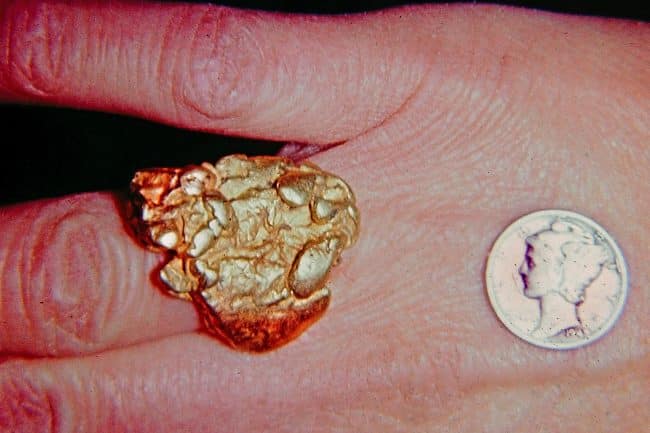
Big Jim’s gold nugget & Mercury head dime
“This is not a gold country, and don’t let anybody kid you,” said Little Jim in a September 1969 interview, recorded three months before his death.
His words may sound bitter, but they’re not. The generally slim pickings from Kenai Peninsula mining never prevented the two Jims from trying for more than 30 years.
In 1973, four years after both Jims had been laid to rest in the Cooper Landing Cemetery, two officials from the Kenai National Moose Range traveled up to the Surprise Creek mine and inventoried what remained.
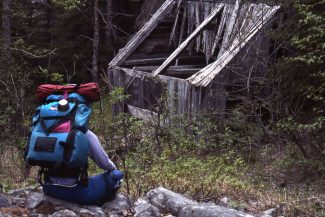
Surprise Creek cabin remains in June 1990
Among the many deteriorating, collapsing infrastructure they catalogued were: an old 10×20-foot barn; part of an old sawmill; two old cabins, including a 12×16 structure containing two calendars and several magazines from 1963; numerous five-gallon cans and 55-gallon barrels; an old generator on wheels; a 12×14 cabin, chewed up by porcupines and built originally from unpeeled spruce logs; an 8×8 screened-in meat-storage building; a 10×12 cabin with its roof falling in and its walls bowing out; an old air compressor mounted on hemlock runners; and a 12×12 machine shop, including parts of a vise and an old forge.
At various times there was even more up there, including a small slab-sided cabin above treeline, just below the Surprise Creek headwaters; a small bridge over a tiny stream the Jims called “Joe’s Creek”; and the remains of a moose-calf corral created and used by the mine’s first owner, Stephan Melchior.
“We did more gold work than anybody in the whole damn country,” Little Jim said. “We spent more money and had more equipment to work with and drove more tunnel than anybody I’ve ever heard of … even if you go clear back to when they first ever done any mining around here.
“We had an Ingersoll Rand J40, the best drill,” he added. “We had a #3 American Sawmill. We sawed thousands of feet of lumber, thousands of feet of planking, sluice boxes and everything else. Thousands of feet.”
Starting in 1939, the Jims began filing placer-mining claims. By 1953, they had 17 on or near Surprise Creek, plus others in the general area. Little Jim estimated that over the years they purchased “about $50,000” worth of equipment, which he doubted they ever made up for in gold. In fact, he said, the only real money they ever made came from trapping during the winters.
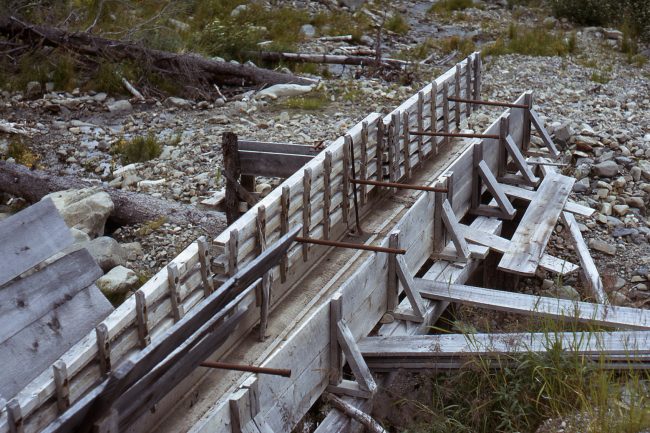
Surprise Creek mine sluice box in 1967.
Estimates vary concerning the tunneling done by the Jims in their attempts to reach bedrock and, they hoped, a mother lode, but the lengths range from at least 900 feet (according to a 1947 Alaska Life magazine article) to about 2,600 feet, according to Little Jim himself.
They also installed a cable crossing between Jim’s Landing and the Surprise Creek trailhead. Then, after the Sterling and Seward highways provided greater access to the general public, the Jims tried to prevent people from messing with their equipment.
They were in the wrong this time, however. Their mining claims gave them mineral rights, not property ownership. The land was then and is now in the public domain. So in 1953 when they blocked their route to the landing with a steel cable and posted it “Private Road,” they raised the ire of federal officials.
Fish & Wildlife director Clarence Rhode called the Jims’ action “trespass” and encouraged immediate legal action. Territorial mining engineer James Williams took a more tempered approach: “It is hoped,” he wrote to Rhode, “that the matter can be taken care of in a manner so as to raise as little ill-feeling as possible. The men involved … are old-time miners in the district, and as (with) most old-time Alaskans, deserve respect so long as they are intentionally law-abiding. … We hope a satisfactory and peaceful understanding with them can be reached.”
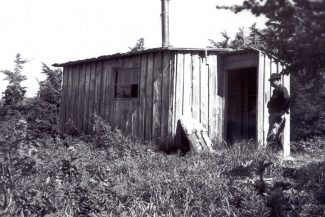
Will Troyer at Surprise Creek Cabin in 1968.
While peaceful, the resolution was hardly satisfying to the Jims. It left such a sour taste in their mouths that, upon retiring from active mining in about 1967, they decided not to surrender their claims to the government, as they had once planned.
Instead, they deeded everything over to heavy-equipment operator Morris Coursen, who soon afterward drove a bulldozer into the mountains, widening and clearing the original Surprise Creek trail.
“The dirty bastards (the feds) had crowded us and had given us a bad time so much,” Little Jim said. “If they would have been decent with us when we couldn’t make it anymore, we’d never have turned it over to Morris.”
In 1973, 49-year-old Morris Coursen also passed away. Over succeeding years, all mining ceased in the drainage, which currently contains no active claims.
“We got the beautifullest, coarsest gold we ever heard of in the whole country around here,” said Little Jim, noting that, while they sold most of what they discovered, they also gave some away to friends.
At 74 and in ill health during his final months, he recalled that he once asked Big Jim, “How would you feel if you got in there where you found a thousand dollars a day? … What would you do?” And faced with the prospect of truly finding a fortune, Big Jim replied, “I’d be damned if I’d know. Just would be the fun of finding it, that’s all.”
“Well, he was right,” said Little Jim. “As old as I am and the shape I’m in, if I had a chance, I’d go again. You never get over it.”
This article series originally appeared in the Peninsula Clarion in Spring of 2021
Read part one here: Coming in for the Landing: An Origin Story – Part One.
Read part two here: Coming Home & Battling a Bully – Part Two
Enjoy these articles? Sign up for our monthly newsletter to be sure to see them or follow us on Facebook or Instagram. Sign up below!
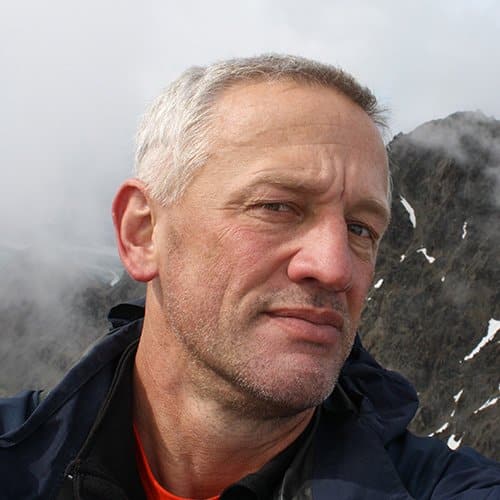 Clark Fair, a lifetime Alaskan now living in Homer, grew up on a homestead in the Soldotna area. He is a former high school English teacher and journalist who now does freelance writing and photography and works part time for Kenai Peninsula College.
Clark Fair, a lifetime Alaskan now living in Homer, grew up on a homestead in the Soldotna area. He is a former high school English teacher and journalist who now does freelance writing and photography and works part time for Kenai Peninsula College.
